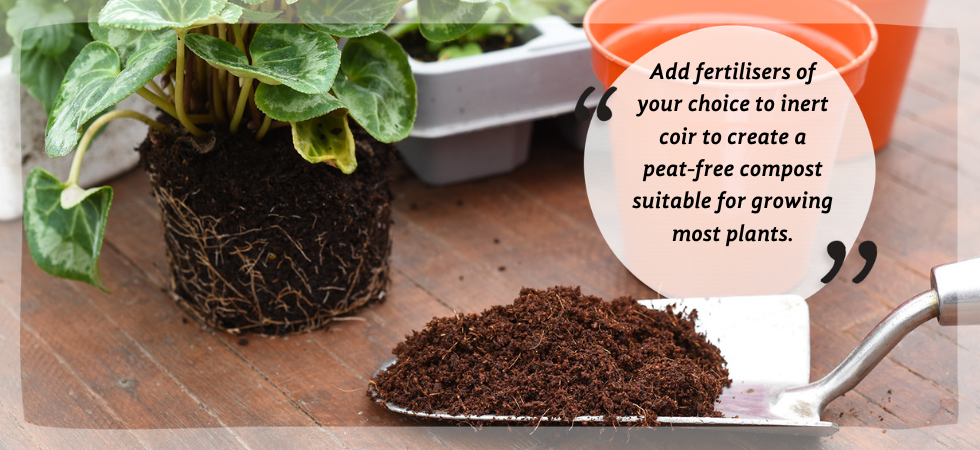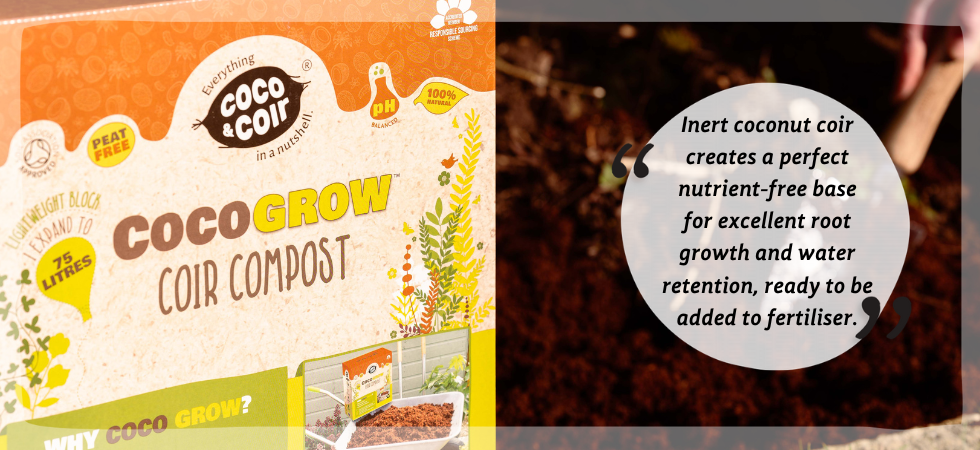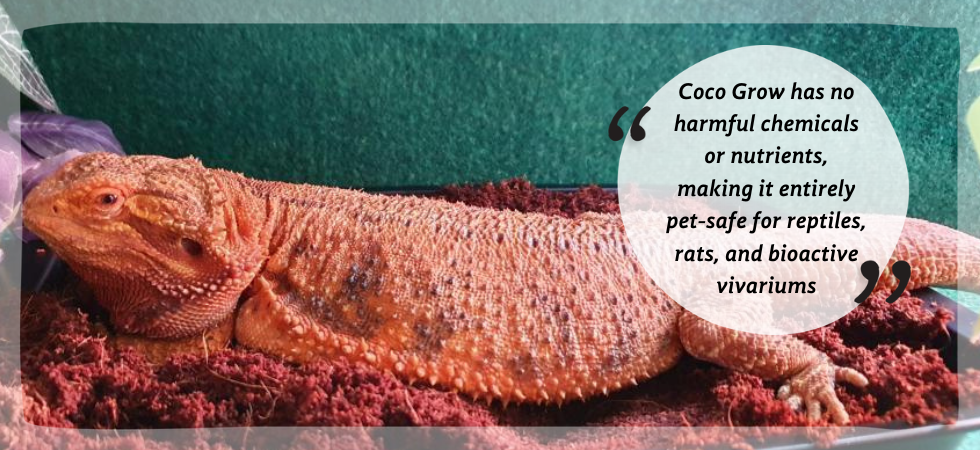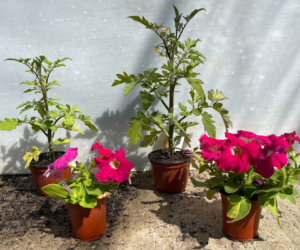How versatile is coconut coir?
“And the award for ‘Most Versatile Plant Ever’ goes to…”
If there were such a competition, our vote would be for the coconut palm tree. It produces coconuts, coconut oil, coconut milk, and of course the miracle material that is its fibrous mesocarp husk. This is the material from which our coconut coir growing media (compost) comes from – and is the basis of most of the products here at Coco&Coir.
There are so many uses of coconut coir – especially our inert Coco Grow. From planting fruit and vegetables to affordable petcare, we have to make a song and dance about all things good and versatile about coir.

Looking for an inert compost?
As a gardener, it’s vital that you give your plants the best possible start. Many gardeners rely on existing soil or home-made compost, which can work perfectly well. But along with the good bacteria and nutrients, they may also carry pests and diseases. Which you might not know about until you start investing your time and energy into growing your vegetables, flowers and herbs.
The solution is to opt for an inert growing medium – ‘inert’ just means it’s chemically inactive. Coconut coir is one option. It’s made from coconut husk and is guaranteed not to contain any nasty bugs or weeds. However high lignin levels mean it does contain good bacteria. And as coco coir is 100% natural and biodegradable, it’s easy to recycle after the growing season. Just pop it on your compost heap.
Another superpower of coir is its water retention and releasing properties. Great if you’re not the best at getting watering can out!
DIY your ideal growing media
If you’ve a very particular plant with a very particular set of needs, you might wish to mix your own growing media. A dash of nutrients here, a handful of perlite there, and then pH neutral coconut coir to bind it all together. Here are some ‘recipes’:
• How to mix potting soil for indoor plants
Using coir for outdoor plants
Mixing pure coco coir into soils or other composts helps make them lighter and airier. This is a real plus for young roots, as they can absorb oxygen more easily, which boosts plant growth.
Just coir or coconut coir compost?
Our coco coir compost blends are coco coir which we’ve enriched with high performance nutrients. They’re a fantastic peat-free alternative to traditional composts, for everything from veggies to prize-winning blooms.
Coco Grow is our most popular blend which contains NPK – nitrogen, phosphorus and potassium which plants love. It also comes in different pack sizes. Just pick the amount that’s enough for your gardening needs:
• Coco Grow 9 litre pack (enough for one large 25cm wide pot)
• Coco Grow 54 litre pack of 6 blocks (enough for 11 x 22cm wide pots)
• Coir compost – Coco Grow 75 litre pack (enough for 2 x large 43cm containers)
Coir for houseplants
The last thing you want is soggy indoor plants rotting in their pots. Adding pure coir will help keep things light and airy. Or simply use Coco Grow in your pots and containers, with nutrients ready and waiting to feed your plants.

Setting up a bioactive small animal cage?
Pets like hamsters, gerbils and rats love to dig. And eat. And chew. Recently there’s been a growing movement towards ‘bioactive’ environments, which allow pets to express these natural behaviours without resorting to more unnatural materials or colourful, ‘unnatural’ additions to their enclosures.
Coir is the perfect bedding material, as you can make it as shallow or deep as you want. You can also scatter dry food into it, encouraging your pet to forage for its supper.
Tip: Don’t want to invest in coir for your pets and coir compost for your plants? Not to worry, our Coco Grow blend works brilliantly for both!
What about burrowing?
If you have pets that love to burrow, coconut coir is the perfect substrate. Slightly damp coco coir allows burrows made by animals like rats keep their shape, giving your pets the freedom to create their own tunnels for exploration and for keeping their minds off of gnawing anything they shouldn’t. Alison of Animallama has a great article on how to keep small animal tunnels fresh and hygienic.
The best bioactive vivarium with coir?
Viva the vivarium! Made out of wood, plastic or glass, a vivarium is an enclosed reptile tank to house all manner of exotic creatures, including lizards, snakes and geckos. A bioactive vivarium aims to create a self-sustaining ecosystem for the animals within it, but also for any plants you choose to spruce up their environment with.
For this set-up to succeed, you need bacteria, fungi and tiny creatures like springtails to work together. And which live on a substrate – as in the bottom layer of material in the vivarium – that can hold on to water, and doesn’t dry out easily. Cue coir! Or rather, a coir compost like Coco Grow, as this will help to boost plant growth within your vivarium as well.
To make sure you get the mix right for your particular pet, it’s important to do your research. Researching how to make a bioactive vivarium for pet lizards and snakes is a great starting point, and experts in the herpetology hobby will be more than happy to advise you on the best conditions in which to keep your pet. Different species require different temperatures and humidity, so always be sure to research!

Coir reptile bedding
Reptiles exist in many different habitats across the globe. When it comes to providing the right bedding for pet reptiles, coir is incredibly versatile. You can moisten it for tropical reptiles. Or for desert-loving species, add only enough water to break the block up. Then let it dry out before adding it to your pet’s environment.
You can either use pure coir blocks or Coco Grow compost for reptile bedding.
Tip: Coir is great at retaining water. But if it’s getting too dry for your pet, spray it with water. We’d recommend replacing all coco coir bedding once a month for optimum health.
Tips from the ‘Green Gardeners Guild’ online advice library
Want more tips about using coco coir? Take a look at our helpful blogs:
• How to use coconut coir in gardening
• Which plants grow in coco coir?
How many ways have you used your coconut coir?
Have you grown a prized petunia in coir? Or used coir to make your prize pet iguana feel at home? From flora to fauna, please share your photos and tag @cocoandcoir on Instagram. Want to get involved and earn £10-worth of loyalty points? Then tell us your story at the Green Gardeners Guild – we’ll credit you for any story we publish. Go on, tell us all that you have been doing in your garden with Coco&Coir!











